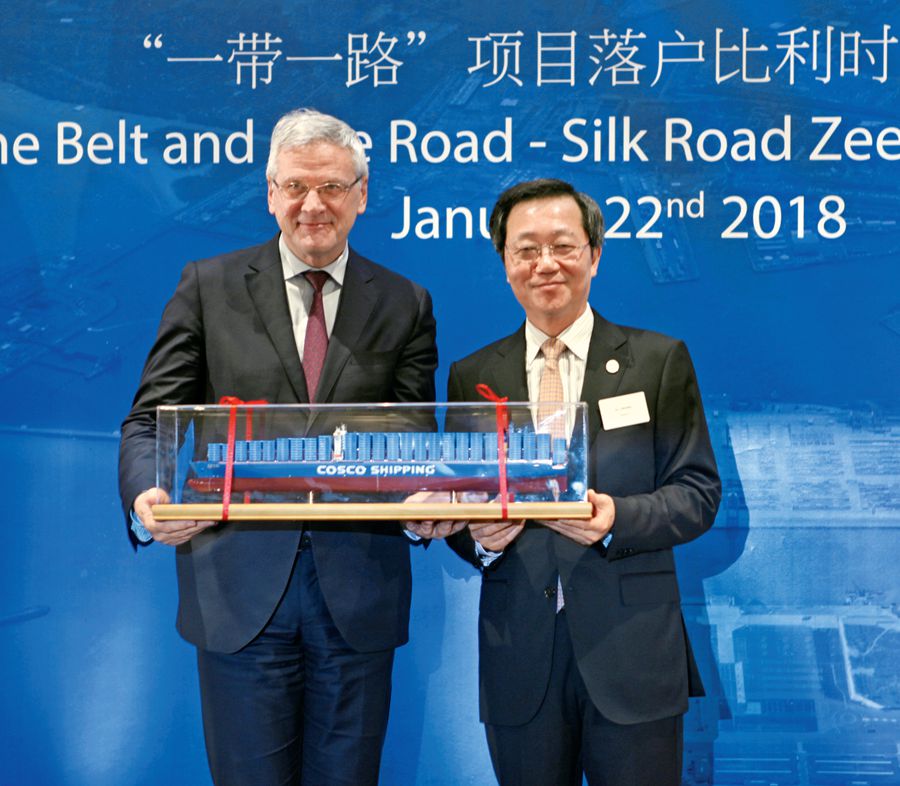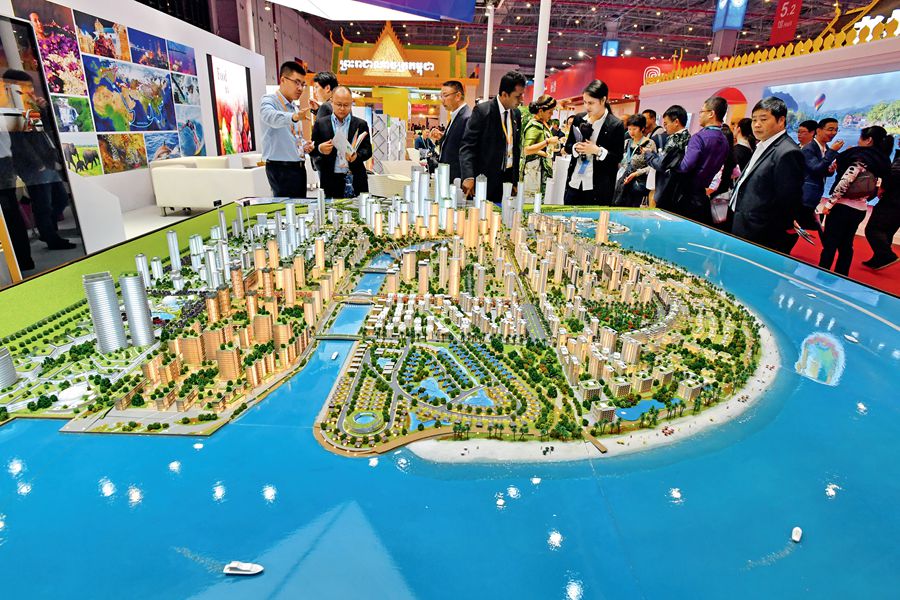THIS year marks the sixth anniversary of the inception of the Belt and Road Initiative (BRI). In April 2019, China will host the second Belt and Road Forum for International Cooperation in Beijing. While welcoming guests from all over the world, we also need to make clarifications on some internationally prevalent misunderstandings about the initiative. Only in this way, can we enhance the people-to-people bonds, realize shared growth through consultation and collaboration, and ensure long-lasting and fruitful cooperation.
Is the initiative a Chinese version of the Marshall Plan designed to fill the power vacuum left by the U.S.?
Among much confusion about the BRI in international public opinion, the U.S. perception and Sino-U.S. relations are important factors. Since its inception, the initiative has continued to forge cooperative partnerships around the world. The international community’s cognition and perception of it is transforming into understanding, recognition, participation, and internalization from the initial incomprehension, non-participation and even suspicion and fear.
The overall situation is gratifying, yet there are still some problems. For example, in some research reports of Western think tanks, they still misinterpret the BRI intentionally or unintentionally. Among the many misunderstandings and distortions, there is one typical viewpoint – China is filling the power void left by the U.S.

On January 22, 2018, COSCO Shipping signs a concession agreement with the Port of Zeebrugge, the second largest port in Belgium, for a strategic partnership.
As the single hegemonic power in the current international system, the U.S. is highly anxious about the rise of China and is highly alert to Chinese initiatives and solutions including the BRI. In this context, some American think tanks and policy advisors tend to interpret the initiative from a geopolitical perspective, arguing, “The true purpose of the BRI is to seek national security,” and it aims to “fill the power vacuum left by the U.S.” Since Donald Trump came to power, the U.S. adopted a protectionist policy which placed the country’s economic dominance in the world, especially in the East Asia-West Pacific region, in jeopardy. Globally, they think only China has both the strength and will to “fill” the “vacancy” after the abdication of the U.S. economic hegemony. The BRI is precisely the specific “strategy” to achieve this goal.
Unfortunately however, all the above observations and subsequent conclusions are based on the misunderstanding of the “imagined facts,” and also accompanied by certain logical fallacies, thus leading to the wrong conclusion.
First of all, the so-called U.S. power vacuum in itself is a false proposition because the U.S. has never stopped its efforts to “protect hegemony” in the East Asia-West Pacific region. At the moment, the U.S. still maintains air and naval military strengths and a large number of military bases in the Asia-Pacific region that exceed the quality and quantity of any country in the region.
From the U.S. Fleet Activities Sasebo in Japan to Naval Support Facility Diego Garcia in the Indian Ocean, to the U.S. military presence in Afghanistan and the Singapore Defence Forces aircraft fleet consigned in the U.S., there is no sign indicating that the U.S. and its military are withdrawing from the Asia-Pacific region. On the contrary, under the new banner of the “Indo-Pacific region,” the Trump administration is quietly pursuing the strategy of “Pivot to Asia” proposed in the Obama era. In fact, the U.S. has never been “away” from the Asia-Pacific region, so how can it “return” if it has never left?
Besides, the U.S. has, in the past and to this day, continued to influence the countries in the Asia-Pacific or Indo-Pacific region, including China, in the political, economic, social, and cultural fields; from Coca-Cola to Hollywood blockbusters, chips in mobile phones and computer hardware, automobiles, and aircraft engines, “Made in the U.S.” is ubiquitous. American values also percolate the world with the booming export of American products and culture.
It can thus be seen that the so-called “U.S. power vacuum” is not in line with objective facts. Then why do some U.S. think tanks, scholars, and policy influencers want to concoct this concept?

The Colombo Port City Project jointly developed by China and Sri Lanka is a key cooperation project under the framework of the Belt and Road Initiative. Yu Xiangjun
The answer is obvious. On the one hand, the rhetoric embodies the new China threat theory in the BRI version. However, the traditional “China threat theory” mainly refers to the development of China, which constitutes a so-called “threat” to its neighbouring countries. This time, they claim China targets the world’s leading power.
On the other hand, anyone familiar with American politics and business operations is aware of the concept of the “military-industrial complex.” It is said that in the U.S., the military industry, members of Congress, the Pentagon, a series of think tanks, and university researchers have been combined into a “community of interests.” They need to constantly hype up “foreign threats” and “create factual basis” for the ever-increasing U.S. military spending, thereby maximizing the interests of their own group.
Is the BRI a means to control the South China Sea?
Another misconception about the BRI is that it is the means used by China to “control the South China Sea.” However, in the past six years, the implementation of the initiative in the South China Sea and the surrounding areas has fully proved the following aspects.
First, China seeks no exclusionary blocs in building the 21st Century Maritime Silk Road, but a highly transparent and open “circle of friends.” On the one hand, it constantly absorbs emerging forces and opens to the entire international community. On the other hand, it continuously provides more international public goods in key areas such as financing, infrastructure, joint search and rescue missions and maritime counter-terrorism.
Second, over the past six years, China has never taken advantage of the BRI to seek so-called “infiltration” and “control” over other countries around the South China Sea. The political development of each country is steadily advanced in accordance with its own national laws and political agenda. People of all countries also elect their own suitable political parties and leaders based on their own interests and wishes.
Today, if there are still extraterritorial forces claiming that “China is attempting to control the countries surrounding the South China Sea by means of the BRI,” they are provoking the legitimate regimes in many Southeast Asian countries and showing disrespect for local people.
At the same time, when countries choose their own development path based on their own national conditions and needs, they also boost their own economic development and social progress by learning from the cooperation, and create opportunities for others.
Since the BRI is not the means adopted by China to “control the South China Sea,” what exactly is it? What does it mean for countries neighbouring the South China Sea?
According to the Chinese government plan, the 21st Century Maritime Silk Road goes westward from the South China Sea into the Indian Ocean and the Mediterranean Sea, and southward into the South Pacific. It aims to connect the European and Asia-Pacific economic circles, but with the focus on Southeast Asian countries.
Obviously, the South China Sea is one of the most important transport routes along the Maritime Silk Road. Whether the South China Sea remains peaceful or not is vital to the progress and speed of promoting the 21st Century Maritime Silk Road.
The Belt and Road plays a role of a “diplomatic officer” that facilitates policy coordination between China and the countries surrounding the South China Sea. It is undeniable that in the process of advancing the BRI, some countries and China were at a certain degree of confrontation over territorial sea issues under the intervention and instigation of non-regional countries.
However, in the past three years of diplomatic practice and policy coordination, efforts have been made to manage the differences between China and relevant countries in dispute on the basis of exchanges and consultation on equal footings. They have continuously strengthened mutual trust and maintained stable and healthy development of bilateral and multilateral relations.
More importantly, with the joint efforts of all parties concerned, the goals of the Declaration on the Conduct of the Parties in the South China Sea (DOC) are moving steadily forward. In the process, the BRI has made critical contributions to policy coordination among countries.
The BRI promotes the connectivity between China and other countries surrounding the South China Sea. These countries, including China, boast hard-working people and rich resources, but still remain underdeveloped. One reason is poor infrastructure. Important railway trunk lines and ports have not kept up with the actual needs of these countries’ development and export.
Based on this understanding, China and neighboring Southeast Asian countries, such as the Philippines, Vietnam, Malaysia, Brunei and Indonesia, have invested in the construction of important ports in joint efforts, so that the countries surrounding the South China Sea can realize unimpeded trade and financial integration through consultation and collaboration brought by the BRI. Such a process has seen a strengthening of people-to-people connectivity along the routes.
In summary, the statement that either “China advances the BRI with the purpose of filling the U.S. power vacuum” or “China makes use of the initiative to control the South China Sea” has proven to be completely wrong. This is because these statements are based on subjective delusions completely inconsistent with objective facts, and distort the original intention of the initiative. These rumors “selectively disregard” the actual achievements of the BRI over the past six years, and then subjectively claim that it is specifically aimed at the influence of the U.S. in the Asia-Pacific region or that the initiative is a kind of geopolitical tactic devised to suppress neighboring countries. Forces with hidden agendas even described the BRI, which advocates openness, inclusiveness and mutual benefit, and win-win outcomes, as a struggle for geostrategic interests, or a way of building hostile political camps for ideological confrontations.
These unintentional misunderstandings and intentional misinterpretations of the BRI are conducive neither to advancing the initiative, nor to self-interests of those countries that mistakenly and credulously believe in rumors. People of insight in China and the international community should unite and act together to make concerted efforts to align regional development strategies of various countries with the Belt and Road Initiative. In this way, they can pursue mutual benefits, and in the end, offer greater opportunities for development across the region.
WANG PENG is an associate research fellow with the Chongyang Institute for Financial Studies in the Renmin University of China.

